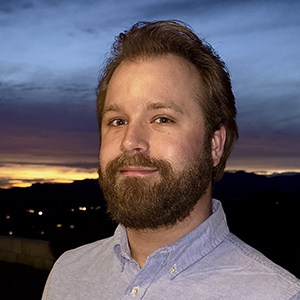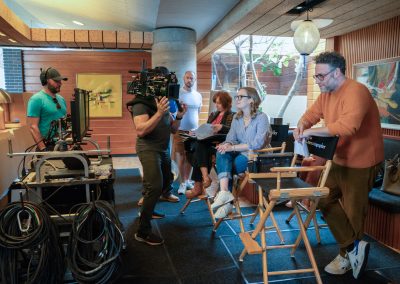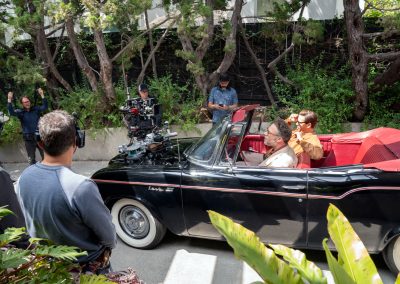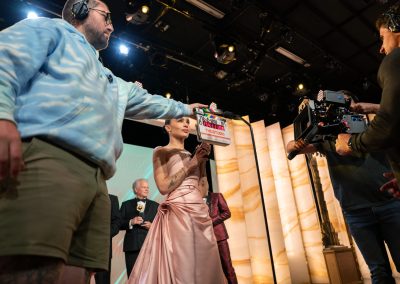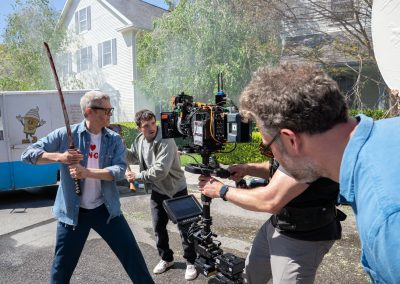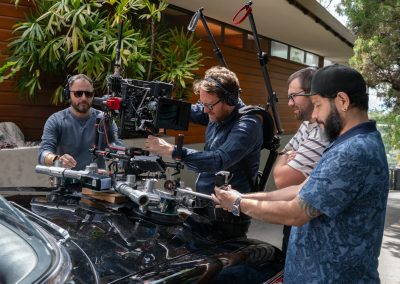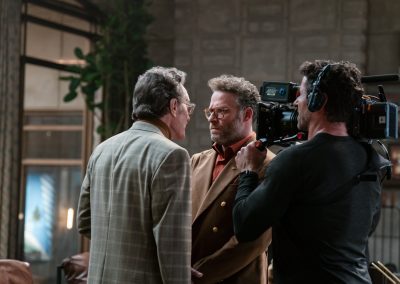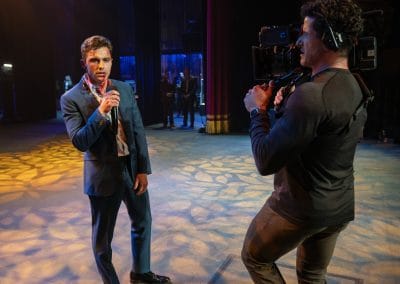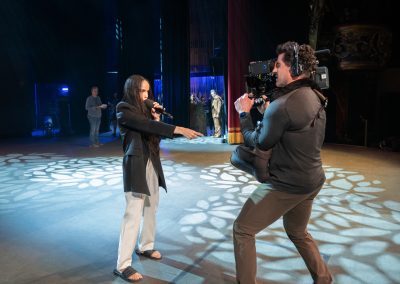The Studio
Making the Camera Honest
A Conversation with Mark Goellnicht, SOC
Hosted by David Daut
At once a biting satire of the movie business and a love letter to the movies themselves, The Studio juggles both the Herculean effort that goes into trying to get anything made in Hollywood with the absurdity of the egos of people calling the shots.
To discuss the series, Camera Operator had the opportunity to talk with both A camera/Steadicam operator Mark Goellnicht, SOC, as well as A camera dolly grip Chris Thrasher about their work. From the series’ frequent use of long takes—including an entire episode presented as a single oner—to adapting the various visual styles of the fictional films being made within the show, The Studio demanded a lot of its camera team. In this feature we get to dig into what was involved in bringing all of that to the screen.
Matt Remick loves cinema. As the newly appointed head of Continental Studios, he aspires to be champion of auteurs, an advocate for shooting on film, and someone who will help bring real artistry back to Hollywood. And what is Remick’s first project as the new head of production? A big budget movie based on Kool-Aid. The Studio is created by Seth Rogen, Evan Goldberg, Peter Huyck, Alex Gregory and Frida Perez and stars Rogen, Catherine O’Hara, Ike Barinholtz, Chase Sui Wonders and Kathryn Hahn.
The Studio
The Dolly Grip’s Perspective
By Chris Thrasher
Camera Operator: Tell us about the relationship between the dolly grip and the camera operator? How do you both work together in the most optimal way? What are some of your communication styles that have worked?
Chris Thrasher: Honestly, it’s not only the relationship between the dolly grip and camera operator, but with the 1st AC as well. That whole triangle is a crucial bond because we’re the problem solvers, making the shot come to life based on the director and DP’s vision. We all collaborate, utilizing each other’s skills, making sure we’re on the same page, and figuring out the best way to attack the shot appropriately. Another key factor of that relationship is trust, because whether the shot involves movement or not, it’s important that the operator can trust their dolly grip to set it up correctly and safely.
In regards to communication with my operator, I’ve learned to stay close to them—especially during rehearsals—and make sure it’s apparent that I’m paying close attention, watching body language as well as hand gestures. It may sound funny, but I feel like a lot of my communication with my operator is purely nonverbal. If it is verbal, we’re usually using HME headsets (either for being on a remote head or for sound reasons) and giving each other countdowns as we begin a move or about to end a mark, so we both time our critical movements. Sometimes it can be as simple as giving each other basic notes on fine-tuning the movement.
CO: Working on The Studio, tell us about your creative contribution with operator Mark Goellnicht to be sure that the challenging shots were accomplished. Was there a shot that stands out in your mind as the most challenging?
Thrasher: As we all know, most of the shots in each episode are single-cam oners, accomplished through handheld or Ronin that switches to a handoff. During pre-production and the tech scout for all the locations, all I really focused on (as much as possible) was figuring out how much of the shot had to be physically handheld, or if there was a piece of equipment we could use—whether it was a dolly, rickshaw, crane, or electric vehicle—that could relieve Mark for the slightest moment during those grueling long takes we were doing daily. For example, whenever the episode took place in the office, the camera didn’t just magically go upstairs—it was either because Mark was running with the camera (leading or following) and I was carefully spotting him up or down custom ramps we made, or we were turning it into a handoff on the crane. On average, we would do four to five shots per day, each shot being anywhere from three to seven minutes in duration, and shoot it about 18 to 23 times until everyone was happy. Funny enough, one of the most challenging shots for me was during Episode 5, “The War,” when we’re in Quinn’s tiny apartment and we had to lead her down these steep stairs. Instead of having Mark handheld going backwards—which would have been super dangerous—I threaded the needle by fitting my hybrid dolly with an Aero Jib on track and turned the shot into a handoff while Mark operated the Ronin, and four other operators on camera and jib, including me on the dolly. That’s the shot you see in the episode.
CO: Your work is physically challenging, how do you manage your health and the stress of the lifestyle? Any advice to give others?
Thrasher: The biggest importance is sleep. I try my best during off-days to recover on sleep and get that back into gear. Afterwards, I focus most on what my job entails, which is cardio, resistance, and endurance. That includes activities like challenging hikes, weight training related to certain aspects of the job (legs, back, core, etc.), and following a strict eating schedule and a healthy diet. My advice is to always take care of yourself and know the limits of your body—it’ll warn you, trust me. Just because it’s a show, it doesn’t mean you should push your limits and severely injure yourself. It’s not worth it.
CO: What advice would you give to a new dolly grip trying to break into the industry?Thrasher: One of the many things I always advise to newer dolly grips is to know all your vendors and rental houses and go visit them. That includes Chapman / Leonard, J.L. Fisher, Elite Camera Support, PROCAM, CineMoves, etc. These are going to be the people who will always be there for you, whether it’s problem solving, solutions to a shot idea, or even coming up with a custom piece of equipment to make it work. It doesn’t stop there either, because I also suggest tuning in to what the SOC or ASC has going on—whether it’s workshops or mixer events—and getting to network as well as overall socialize with people in the industry. Get your name out there and start getting your hands dirty.
BEHIND-THE-SCENES
Select Photo for Larger View
Camera Operator Spring 2025
Above Photo: Chris Thrasher & Mark Goellnicht, SOC, shoot a scene for THE STUDIO
Photos courtesy of Apple
TECH ON SET
ARRI ALEXA 35 Digital Camera
21mm ARRI Master Prime Lens used throughout
Mostly shot traditional handheld with DJI Ronin 2 & Ready Rig VEGA
Magnets, Cradles & Ascension Rig with Technocrane integration
RELATED CONTENT
Watch the trailer for The Studio
Mark Goellnicht, SOC
Learn more about Mark‘s career and projects at IMDb.com
“Hacksaw Ridge: Shooting Inside a Battle,” Winter 2017 Camera Operator
Chris Thrasher
BEHIND-THE-SCENES
Select Photo for Slideshow
SIGN UP FOR THE FREE
DIGITAL EDITION OF
CAMERA OPERATOR
Click Here
Mark Goellnicht, SOC
Mark’s career in film and television began in his home town of Perth, Western Australia. After cutting his teeth on local television productions he moved to the larger Sydney market, gaining experience on bigger Australian and US movies like Peter Pan, Stealth and GhostRider, leading to a greater desire to expand and diversify his credits abroad. In 2009, Mark’s dream of working with the very best in the craft of film making led him to move to Hollywood, and he has resided in Los Angeles, California, ever since.
Mark has had the opportunity to work with some of the world’s finest directors and cinematographers, namely three outings with director George Miller on Mad Max Fury Road; Three Thousand Years of Longing; and Furiosa: A Mad Max Saga—all as A camera/Steadicam operator—along with Bong Joon Ho on Okja; Baz Luhrmann on The Great Gatsby; and Joe and Anthony Russo on Captain America: Civil War. Working with Mel Gibson, director of Hacksaw Ridge, earned Mark a nomination for SOC Camera Operator of the Year. More recently, his credits include the newly released hit series The Studio, directed by Seth Rogen and Evan Goldberg; Bono: Stories of Surrender, directed by Andrew Dominik; The Wrecking Crew, directed by Angel Manuel Soto; and the soon to be released Predator: Badlands, directed by Dan Trachtenberg.
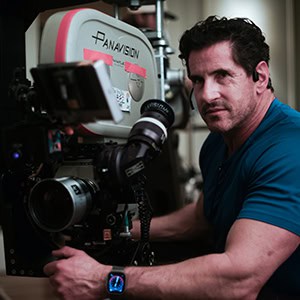
Chris Thrasher
Christopher Thrasher is an LA-based Local 80 dolly grip. Originally starting off as a SFX tech and utilizing the Dolly boom arm for practical tricks, Chris would later find that dolly grip was another career path. From there, he moved on from the Special Effects world and started pursuing the art of camera movement. Over the next decade, Chris would turn his job into a science and know the dolly inside and out, as well as cranes and many other tools to better his workflow. In that time, he’s worked on projects such as The Studio; The Old Man: Season 1; Star Wars: Skeleton Crew; The Call Of The Wild; The Greatest Beer Run Ever; and, most recently, Mercy.
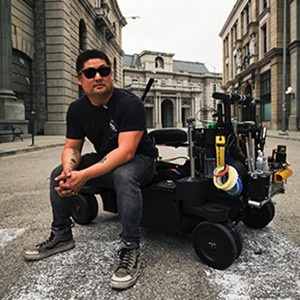
David Daut
A writer and critic for more than a decade, David Daut specializes in analysis of genre cinema and immersive media. In addition to his work for Camera Operator and other publications, David is also the co-creator of Hollow Medium, a “recovered audio” ghost story podcast. David studied at the USC School of Cinematic Arts and works as a freelance writer based out of Long Beach, California.
